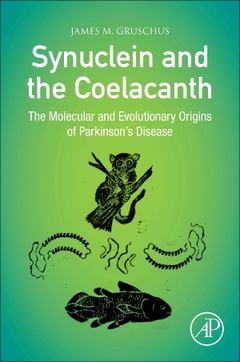Synuclein and the Coelacanth The Molecular and Evolutionary Origins of Parkinson's Disease
Auteur : Gruschus James M.

Most neurodegenerative diseases have animal parallels such as Alzheimer?s in chimpanzees, multiple sclerosis in macaques, Lou Gehrig?s disease in dogs, but nothing like Parkinson?s has ever been seen in any species but humans. Synuclein and the Coelacanth: The Molecular and Evolutionary Origins of Parkinson's Disease delves into the causes of Parkinson?s disease and how the evolution of the human brain has left us uniquely vulnerable. Genetic risk factors, environmental toxins, and neuroanatomy are woven together in a multidisciplinary discussion that ranges from subatomic physics to socioeconomics. Connections between neurodegenerative disease, neural pathways, and innate immunity are explored. Finally, the author discusses new therapeutic agents are being developed that hope to go beyond just treating the symptoms of Parkinson?s and actually halt the disease.
- Proposes a new hypothesis on the origins of Parkinson’s disease
- Examines genetic risk factors, environmental toxins, and neuroanatomy of PD
- Highlights new therapeutic treatment options in development for patients
Date de parution : 02-2021
Ouvrage de 312 p.
15x22.8 cm
Thème de Synuclein and the Coelacanth :
Mots-clés :
Adenoassociated virus; Adenosine triphosphate; Alpha-helix; Alzheimer's disease; Amyloid oligomer; Antibody therapy; Ashkenazi; Asthma; Beta-sheet structure; Biomarkers; Blood-brain barrier; Braak staging; Brain size; Brain trauma; Brain waves; Ceramide; Cerebellum; Chemical chaperones; Chimpanzee; Coelacanth; Coimmunoprecipitation; Correlated mutation analysis; Crohn's disease; Cryoelectron microscopy; Deep brain stimulation; Desmethylprodine; Direct pathway; DNA; Dopamine; Environmental risk factors; Environmental toxins; Essential tremor; Ethanol; Evolution; Founder effect; Ganglioside; GBA1Glucocerebrosidase (GCase)Lysosome; GCTA; Genetic code; Genetic risk factors; GM1Rapamycin; Gut; GWAS; Homunculus; Hub proteins; Hydrogen bond; Indirect pathway; Innate immune response; Intelligence; Ion dyshomeostasis; IQ; Knock-in; Knockout mouse; Kuru; Levadopa; Lewy body; Lewy neurite; Lobotomy; Locus coeruleus; LRRK2Olfactory epithelium; Lysosomal storage disease; Mad cow disease; Marijuana; Membrane disruption; Mendelian mutations; Mitochondria; Motor cortex; Mouse lemur; Movement-related learning deficits; MPP+MPTP; Neuromelanin; Nonhuman primate; Nuclear magnetic resonance (NMR)Peptide structure; Parkin; Parkinson's demographics; PINK1Prion protein; Protein degradation; Pull-down assay; Rapid eye movement sleep behavior disorder; Reactive oxygen species; Rhinitis; Socioeconomic factors; Striatum; Superhelical twist; Synapse density; Synthetic opioid; Synuclein overexpression; Tau; Transgenic; Variant Creutzfeldt-Jakob disease; Vesicle binding; X-ray crystallography; Yeast two-hybrid



